
This page last modified: 28 August 2003.

This article intends to help clarify the enigmatic nature of imperial Roman lanciarii, about which the consensus of recent opinion seems to be that they were a form of "legionary light infantry". Lanciarii (singular 'lanciarius') are alternatively spelt in the sources 'lancearii', that is "lancea-men"; the lancea being a shafted weapon mainly used for throwing but also being capable of used as a thrusting weapon retained in the hand. It is cognate with the Greek 'longche' and hence the 'longchophoroi' or "longche-carriers" frequently found in Greek literary sources. At first site it would seem obvious that a man carrying a lancea is a lancearius and vice versa. This of course assumes we know exactly what a lancea is, but even assuming we do, the world is frequently less tidy than that; how many 21st century 'armoured cavalry' units actually ride horses for instance? Thus for the moment I will put aside the assumption that a lanciarius derives his name from his offensive arms.
The main problem I have with this formulation of lanciarii as "legionary light infantry", as advocated by the likes of Spiedel et al., is the gravestone of Aurelius Gaius, ca. 300 AD, describing him as serving as an IPPEUS LANKIARIS, ie. a cavalry lanciarius (AE 1981, 777; see B.Campbell's "The Roman Army, 31 BC - AD 337, a Sourcebook"; Routledge, 1994, p 240, for a translation and commentary) - ie. not an infantryman at all let alone a light infantryman. Thus while it is possible that some lanciarii could have been light infantry, this proves that not all were; and if not all were, one must ask if any were.
The first evidence for Roman lanciarii seems to come from Josephus, the Jewish author writing in Greek during the 1st century AD. He notes that a provincial Roman general is attended on the march by guardsmen on foot he terms longchophoroi. See S. van Dorst's excellent web-site for the text and a commentary. These men seem to be drawn from the ranks of the legion that the general commands. The usage of longchophoroi as a term for a 'guard' seems to hark back to the pre-classical Greek usage of 'doruphoroi' (ie. "spear-carriers") as a synonym for bodyguards. Indeed, the association of bodyguards with tyrants led to the word doruphoroi acquiring extremely negative connotations, and its seeming displacement from contemporary vocabulary.
Similar men are also attested in the 2nd century AD by Arrian, also writing in Greek. He notes that the Roman army he is to command in battle against the Alans includes various types of 'longchophoroi'. Some of the auxiliary troops are described as this as well as fully half of the regular legionaries, who throw their weapons overhead of the other half (who are seemingly armed with pila used for thrusting rather than throwing, and called 'kontophoroi' - apparently thereby avoiding the use of the word doruphoroi); he also describes his foot guards as longchophoroi, distinguishing them from the rest by describing them as 'kouphoi' or "light". As these guards are said to accompany him as he moves from place to place along the battle-line, this presumably refers to their equipment being physically lighter than that carried by the other longchophoroi, and this seems to be the main reason lanciarii are presently thought of as 'light infantry'. However, whether this was standard practice or a temporary measure so that they can keep up with their mounted general as he moves about the battleline is unclear. Arrian's complete text is also found on S.van Dorst's site along with a translation and commentary. In Arrian's anti-Alanic treatise then, longchophoroi are termed as such because of their equipment, and any longche-bearer is a longchophoroi; but he does give notice of a select group of such men attendent upon a general in the manner of Josephus, and thus it is entirely rational to conclude that Josephus' longchophoroi are also armed with longche.
The first instance of a soldier termed a lanciarius in Latin seems to come from the gravestone of Aurelius Mucianus, a soldier from Legio II Parthica, where he is described as a 'Discens Lanchiari(....)' on his headstone in Apamea dated to the early 3rd century AD, ie. a "trainee lanciarius". This man's tombstone is illustrated in J.C.Balty's "Apamea in Syria in the Second and Third Centuries A.D." in the Journal of Roman Studies, 78 (1988), 91-104, along with a discussion on the dating of the gravestone. Apamea was a Greek-speaking area, hence the hybrid spelling used; and he is shown holding 5 large javelins - ie. lanceae, in his right hand, while his left hand bears a shield. The shield appears to be oval (a foreshortened round shield can not be ruled out however), with a central round boss, and its small size would well fit the light infantry hypothesis. However, it can be readily seen that the other numerous gravestones from Apamea showing (non-lanciarii) legionaries who carry shields have them depicted the same small size, so the conclusion that the size of the shield as depicted is much smaller than real-life is unavoidable, and it is in all likelyhood no different from any other legionary shield. This man's position in Legio II Parthica makes it plain that, at least at this date, lanciarii were drawn from the ranks of the legionaries; his almost unique tombstone amongst many dozens indicates that the limited numbers of lanciarii attested in Josephus and Arrian - one or two hundred in a force of many thousands, continued into the 3rd century. In addition to Mucianus, one other lanciarius, not a discens, also has a tombstone at Apamea; he is shown holding 4 lanceae.
Very recently, following discussion of an earlier draft of this article, Duncan Head made the observation that the first appearence of lanciarii in Roman armies seems to be occur around the same time as antesignani disappear from the sources. Antesignani, "those before the standards", undoubtably formed part of the standard heavy infantry line of battle in the Punic wars (eg. Livy 23.29.3), but they seem to have taken on some of the roles of the former light infantry (velites) as the 1st century BC progressed - when the velites themselves finally disappeared from the scene. Most notably in Caesar, they can be found supporting cavalry, seizing advanced positions etc. There is some evidence that they may have been more lightly equipped than other legionaries, at least some of the time, and in such roles, lanceae may have been more suitable weapons than standard pila. Perhaps this practice became codified in early empire, as did so many other aspects of the Roman military. In this case, we might well not only conclude that lanciarii were legionary light infantry, but that they were merely an old troop-type under a new name.
Several mentions of lanciarii from gravestones are attested from the Tetrarchic period - the end of the 3rd century AD and start of the 4th. Brian Campbell amongst others has proposed, on the basis of such inscriptional evidence, that lanciarii were associated with the 'comitatus', and formed part of it (p 238 of his above-mentioned sourcebook) . The 'sacer comitatus' ("sacred retinue", sacred because the emperor was invested with divine attributes) was the small mobile field force accompanying the Tetrarchic emperors such as Diocletian and no doubt had its roots in the previous strategic reserve forces organised by the likes of Galienus, and ultimately stretching back to the creation of Legio II Parthica (see Balty's above-mentioned article and references therein).
I might go further and suggest that all the soldiers of Diocletian's comitatus, being the emperor's escorts in the field, were styled lanciarii. From Campbell's analysis (p 238) of the career of Valerius Tertius it seems that a lanciarius ranked above a legionary, but below a Praetorian guardsmen in the same way that later, a 'comitatenses' (member of the later-period comitatus) ranked above a 'limitanei' ("border" or "frontier" garrison soldier), but lower than a member of the 'scholae' (the guards). Such ranking between a normal legionary and a Praetorian to my mind better fits a lanciarius being a distinct 'status' of soldier as a guardsman rather than a distinct functional 'type' of soldier like "light infantryman" (especially since light infantry were normally regarded in the ancient world as being of inferior status compared to heavy infantry).
In this regard, the well-known Piazza-Armerina mosaics bear scrutiny (see also here). These delightful illustrations from Sicily are dated to the early 4th century AD, the latter half of the Tetrarchy. Included in the scenes are depictions of men, apparently soldiers, hunting wild beasts such as elephants and lions, these no doubt being destined for the circus.
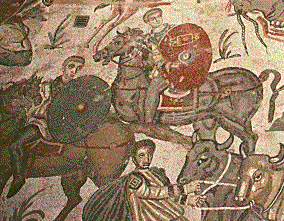
|
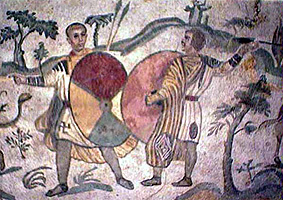
|
Illustrated above are some of the soldiers depicted in the mosaics. They wear typical later Roman dress styles with their prominent decorative patches, and carry shields decorated in the manner of the Notitia Dignitatum dating from some 100 years later. Both cavalry and foot are depicted unarmoured, lacking even helmets, as is typical of illustrations of the era, and this was also the fashion a century earlier as shown by the Apamea gravestones. We therefore cannot say for sure if they wore any armour in real-life or not. It is noticeable that the weapons carried appear to be lanceae given their light shafts and that they are being thrown; the impressive realism of these mosaics makes the dentification of such details more confident than is the case with crudely-carved gravestones. Note also the realistically large shields of the footmen, contrasting with the under-sized representations of a hundred years before.
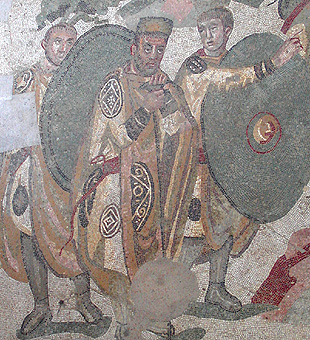
|
To the right we see see this lordly figure with his bodyguards, as depicted in another section of the mosiacs. It seems that this is the villa owner, and that he is either a very senior ranking official, or indeed, the highest-ranking official - an emperor - in the Roman hierarchy (the Tetrarchy was characterised by its multiple emperors, officially four, two senior men entitled 'Augustus' and two junior men entitled 'Caesar', but in practice there were often more or less than this). Thus the men shown here, and possibly others shown above in addition, will most likely be members of the sacer comitatus. |
That cavalry could be called lanciarii might seem surprising, but cavalry longchophoroi are found in Greek literary source such as Diodoros, and Arrian in his tactical manual, the 'Techne taktike', describes Roman cavalrymen carry two longche each, so there is nothing surprising about this in a technical weapons-related sense. After presenting an earlier version of this article on my web-site, Ross Cowan brought to my attention two papers by RSO Tomlin discussing the use of lanceae in Roman Britain: 'Roman Manuscripts from Carlisle: the ink-written tablets', Britannia 29 (1998), 31-84, and 'The missing lances, or Making the machine work' in A. Goldsworth & I.Haynes (eds.), The Roman Army as a Community, JRA supp. ser. no. 34 (1999), 127-38. I have been unable to view either of these myself, but have been informed that the former at least concerns a letter dated to around 100AD in which a decurion reports the loss of lanceae from various members of his unit - a cavalry ala - in which each trooper appears to be armed with both a lancea and two other weapons termed 'subarmales' - apparently light javelins. This confirms that the usage of weapons called lanceae was not just restricted to infantrymen even in the relatively early Imperial period.
More to the point, Campbell's notice of a cavalry lanciarius from the Tetrarchic period shows that lanciarii (as opposed to men carrying lanceae, who may yet have been called something other than lanciarii) were indeed not purely limited to being infantrymen. This reinforces the impression that the classification of lanciarii was, at least by this stage if not before, by status as guards as much as by function/weaponry. This is in no way inconsistent with previous usage, because the very legion we have epigraphic evidence of lanciarii for - Legio II Parthica, was the very legion that was constantly in attendence upon the emperor at the time. This legion was the first to be 'permanently' stationed just outside Rome, and later accompanied the emperors on their eastward campaigns against the Parthians. It is possible that every legion may well have had its complement of lanciarii to escort generals and other noteables, as suggested by Arrian and Josephus, but if any single legion should be expected to have a portion of its men employed as Imperial guardmen, it is this one, the very one we have evidence for of lanciarii.
Imperial guardsmen went by various names under the Tetrarchy - we hear of both 'protectores' and 'scutarii' for instance. There is no reason to believe a scutarius (literally "shield-man") could not simultaneously be a lanciarius any more than we have no reason to believe a scutarius could not simultaneously be a 'sagittarius' ("archer", such a combination being reported in the Notitia Dignitatum for instance where a scholae unit is entitled 'scola scutariorum sagittariorum'). Guardsmen are not particularly limited in the types of weapons they can employ, but there is evidence to suggest that javelins - lanceae - were considered particularly appropriate when escorting eminent personages. Aside from the obvious fact that in Josephus and Arrian, general's guardsmen are termed longchophoroi, it is noteworthy that depictions of Praetorian guardsmen often, if not always, show them carrying the lancea rather than the pilum.
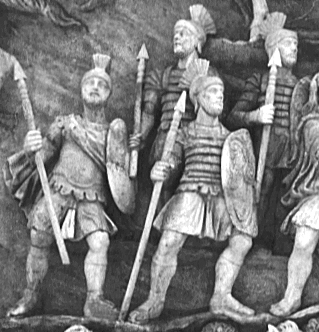
|
To the right are Praetorian guards as shown on the 2nd century AD Antonius Pius relief - note the stylistically under-sized shields and the lanceae. The carrying of the lancea may have been a traditional carry-over, although there is no direct evidence to suggest that Republican-era Praetorian guards were armed differently from other soldiers. However, according to Polybios, it was the duty of Italian allied soldiers drawn from the ranks of the extraordinarii to guard the consul in his camp, and it is not implausible to suggest that such troops may have been armed with lanceae rather than Roman-style pila: our limited sources do not tell us what the bulk of Rome's allied soldiers were armed with, let alone the picked elite, but archaeological evidence makes it clear that the lancea was a popular weapon with many Italians peoples before they were conquered by Rome (see M.T.Burns, The Homogenization of Military Equipment Under the Roman Republic, Romanization, Digressus Supplement 1 (2002), 60-85, discussing A.Small's archaeological findings, and available online at http://www.digressus.org/). All of Rome's Italian allies had been granted citizenship circa 80 BC as a result of the 'Social' (ie. "allied") war, so the distiction between allied and Roman soldiers vanished, and with it the traditional allied service of guarding the army's general and headqurters. |
But even if javelin-carrying by Roman guardsmen was not a relic of the past, there are good reasons why javelins make especially suitable weapons for bodyguards. Having a missile weapon is advantageous for a bodyguard - with luck, an attacker can be brought down before he reaches his target. Bows in this regard are not very useful, since it takes considerably more time to draw an arrow, nock it and release it than it does to throw a javelin or dart already in the hand, even if the bow is kept permanently strung (which would soon render the bow useless). But having just a missile weapon is obviously less than ideal - an attacker who penetrates through the guards to get to his victim cannot be easily dispatched with missiles for fear of hitting the victim; a melee weapon is obviously required. Spears with their long reach seem quite suitable, but have the disadvantage of being of less utility indoors than outside. Fine on the march, if not in a tent, and not so useful in the collonades of the average palace. Javelins however, especially the larger variety, seem to combine all the required attributes into one weapon. Thus it should come as no surprise to find that Praetorian guardsmen were frequently armed with javelins, and that legionaries acting in the same capacity as guardsmen were also armed in the same manner - and hence termed lanciarii after the weapon they used. By this reasoning, an extension of the term lanciarius to cover any member of the imperial bodyguard during the Tetrarchy, even if such men were not armed with the lancea, should cause us no surprise in the same way that the term Praetorian guard was no longer confined to a soldier guarding the commander-in-chief's headquarters in the army's camp, but had previously been extended to encompass guarding the headquarters of the empire itself; Rome and its emperor.
The comitatus in Diocletian's day was a relatively small force, but during the course of the 4th century, it was considerably expanded (at the expense of the border or front-line force); so much so that by the time of the Notitia Dignitatum it was itself was sub-divided not only into several discrete armies but into 'palatina' and 'comitatenses' units with the former being regarded as the more senior. This expansion was due to Constantine the Great (and bitterly criticised by the pagan historian Zosimos over a hundred years later), and it is from just after his death that were first hear of the special officers of the comitatenses forces that are so well documented in the surviving copies of the Notitia Dignitatum, the "List of Offices" or better, the "Register of Dignitaries" (but see here for an argument against using this name).
The Notitia Dignitatum lists a number of units styled lanciarii. In the west: the Lanciarii Sabarienses, the Lanciarii Gallicani Honoriani (or Lanciarii Honoriani Gallicani), the Lanciarii Lauriacenses and the Lanciarii Comaginenses; and in the east, the Lanciarii seniores, the Lanciarii iuniores (two different units), the Lanciarii Stobenses and the Lanciarii Augustenses. All are legionary infantry units. The names of these units implies that every member of them is a lanciarius, and therefore advocates of the lanciarii being light infantry integral to the legions would have to explain how such separate units come into being. One rationale is that the lanciarii components of each legion had at some point in the past been separated out and then combined together to form these all-lanciarii units, as suggested by P.Barker (DBM Army lists, volume 2, 1998, WRG; although doubting that these combined units then operated as anything other than 'normal' legionary infantry), although the reasons behind why this should have been done are not explored. As the Lanciarii seniores is listed as the army's most senior legion, Phil Barker suggested that this particular legion was the result of Constantine amalgamating all his legionary light infantry into a single elite legion.
Rejecting the light infantry formulation at this date, I would modify this to say that Constantine's lanciarii were already a single formation inherited from his father, the then senior Augustus of the empire, Constantius "Chlorus", when Constantine was first acclaimed to the purple in 306 AD after Chlorus' death, and that this formation was simply his father's guards - his lanciarii, which fits in even better with the legion's elevated status than an amalgamation of light infantry units. It might then come as no surprise that it included no cavalry - Constantine was particularly weak in cavalry to judge from the few battle accounts that have come down to us (or his enemies particularly strong), and we have no reason to believe his original army, based on the British units that acclaimed him in York, contained any cavalry guards. What then of the other Lanciarii units mentioned in the Notitia, and what of the lanciarii of Constantine's rival tetrarchs?
As we have seen, no lanciarii cavalry units are included in the Notitia Dignitatum. Therefore, either they had been disbanded in the meantime, renamed as some other sort of unit (perhaps one of the several Equites scutarii, or horse guards, attested in the Notitia Dignitatum), or that the lanciarii equals comitatus guardsmen theory is somehow wrong (not that positing lanciarii as legionary light infantry helps explain cavalry lanciarii of course). Most of the lanciarii units mentioned in the Notitia Dignitatum are ranked quite lowly - some even being termed 'pseudocomitatenses' - that is border-troops recently promoted to the field army due to a military emergency. This would at first sight seem to run counter to the proposal that lanciarii were high status guards. However is it likely that Constantine after his victories over his rivals would have kept their guards in a favoured position? This seems most unlikely, and indeed, it is well-known that he had disbanded the Praetorian guards after capturing Rome, who were no doubt not exactly keen on serving their conquerer. What became of the other guardsmen employed by his rivals however is unknown. If he did not disband them outright, then demotion by sending them to the frontier where they could still serve a military purpose without being a likely threat is only to be expected; one is reminded of Antigonos One-eye who did exactly the same thing with the elite Argyraspides who had supported his enemy Eumenes.
The geographically based names of some of the Lanciarii units, such as Comaginenses, might imply that they were raised in the area concerned, which would ill-fit guardsmen who would have been most likely assembled piecemeal from various existing units rather than recruited en masse from a particular locale. This argument can be pressed too far however. Many have taken it for granted that a 'Gallic' unit listed in the Notitia Dignitatum orginally came from Gaul for instance, but there are surely many ways in which a unit could be given such a descriptive name. It is after all hard to imagine how a unit of Atecotti, ie. 'Scots', such as the Atecotti iuniores Gallicani, could nonetheless be raised in Gaul. While it seems indeed possible, even probable, that a unit of 'Parthian' horse archers was originally recruited from Parthians, noted horse archers, many of whom may have fled the Sassanid Persians into Roman service in the early 3rd century AD, not all 'Parthian' units were like this: Legio II Parthica was so named in anticipation of its intended role in a future campaign against the region. Similarly, there seems no reason to believe that units of lanciarii should come from the small towns of Comagine or Lauriacum in Noricum anymore than Legio II Parthica came from Parthia. These units were merely stationed there just prior to being incorprated into the field army when the Notitia was composed.
Many of the legionary units listed in the Notitia are fragments of much larger units split up over the decades. How many of these fragments came by their new names is something of a mystery - but what would be more natural than naming a newly created unit after the area it was first posted to after being split from its parent? Thus the Lanciarii Comaginenses, far from having been recruited in Comagine, may simply have been posted there immediately after being split off another unit of lanciarii some time in the past. Honorius need not have recuited his 'Gallic' lanciarii, he may have just been the one who caused the unit's formation by splitting it off from another unit of lanciarii. He would have been no less its founder for it. Likewise Constantine may have taken the lanciarii of one of his defeated rivals, split it in two, and posted both to the frontier, with one half going to say Comagine and the other Lauriacum.
Thus I would posit a combination of factors led to the status, type and number of the Lanciarii units noted in the Notitia Dignitatum. We have no way of telling from it alone how many Tetrarchic-period lanciarii units were disbanded, or even renamed in such a way that they were called something other than lanciarii - but it is easy to believe that some of the units enumerated might well have been ex-lanciarii formations. Others may well have been the result of carving up lanciarii units into ever smaller fragments. They may not have even been created from units that bear the title lanciarii in the Notitia Dignitatum. While this might seem a bit untidy and 'woolly', it is clear that the lanciarii units in the Notitia Dignitatum cannot simply be "legionary light infantry" either, in that they are obviously separate formations of troops, and hence Phil Barker's expression of doubt that they were by this date probably not light infantry, even if he believes they had been before. But if they were not light infantry in the late 4th century, one must perforce ask if they were before that date.
We have seen that lanciarii could indeed be armed in manner that suggests they could be used in this fashion, since they could carry weapons suitable for the purpose, and could operate 'lightly' equipped. But this does not mean that this was their only, or even normal, mode of operation. Preatorians too could carry lanceae, and routinely appeared going about their duties unarmoured, yet nobody would contend that, when serving in the field, they were javelin-carrying light infantry! It is only natural that picked troops - and lanciarii such as Legio II Parthica's discens lanciarius Aurelius Mucianus were clearly picked in that they needed additional training to carry out their duties - could operate in more than one role. To however conclude that they normally operated in such an 'alternative' role is however a grave mistake.
Paul Holder and Graham Sumner in their article "Legio II PARTHICA: A Third Century Legion", Military illustrated, 48 (1992), 18-23, recreated the appearence of Aurelius Mucianus. They gave him a round shield in contrast with the oval shield of a non-lanciarius member of the legion, although on what basis I cannot tell, as all the shields depicted at Apamea are the same distorted size. Furthermore, the shield patterns chosen were not the simple cross depicted on one tombstone at Apamea (Aurelius Mucianus', along with most of the other soldiers at tombstones at Apamea, is undecorated), but rather those taken from the 'legionary' bath-house at Alba outside Rome, near where Legio II Parthica was orginally stationed.
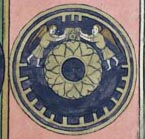
|
It is interesting to note that these patterns are stylistically similar to a pattern depicted in the Notita Dignitatum, that of the eastern Domestici Pedites, as shown to the right. One of the bath-house patterns in particular is almost identical, except for the angels holding the imperial image, an obviously 4th century Christian embellishment. |
That this pattern, belonging to the most elite unit of foot-guards in the later Empire, is so similar to that shown in the bath-house at Alba cannot be coincidental. This would suggest that this shield pattern, and presumably the unit that bore it, had a continuous history throught this era. If the shields shown at Alba really do represent those of Legio II Parthica, as opposed to various guard units stationed in or around Rome, then their varied nature would support the idea that each cohort carried different shield patterns, and that one of those cohorts - a cohort of lanciarii - became the later eastern Domestici Pedites.
To conclude then, I would suggest that imperial Roman lanciarii had their origins in the republican Antesignani, as suggested by Duncan Head, and their alternative new name reflected their armament, distinct from standard legionaries; that they were picked troops in that they could and did perform extra duties over and above normal legionaries - which included sometimes serving as 'light infantry' but were no way limited to such a role, and that another important function was as bodyguards and escorts of generals and the like. This guarding function led in the late 3rd century to the term lanciarius connotating 'Imperial guard' in much the way 'scutarius' came to, so that the term came to embrace non-legionary guards as well. In the 4th century, most of these lanciarii units were no longer employed as guards.

Postscript
Duncan Head has suggested to me another possible interpretation of lanciarii. Arrian described two types of longchopohoroi - not only is the select group guarding his person so described, and also fully half of the regular legionaries, who throw their weapons overhead of the other half. It has long been debated how relevant Arrian's description is to the rest of the Empire, as opposed to just legions campaigning under him in Kappadokia, but Duncan notes that a similar split amongst the legionaries can be found in a papyrus from Panopolis in the Chester Beatty Library Dublin, detailing donative records of Legio II Traiana in Egypt ca. 300 AD, from which it appears something like 45% of the men mentioned are lanciarii (see Terence Coello's discussion for the numbers in "Unit sizes in the Late Roman Army").
Now clearly these lanciarii are not select guardsmen if they make half of the legion's strength; equally clearly they are not part of the comitatus, since they are part of a standard Egyptian garrison legion. Thus there appear to have been two different sorts of lanciarii in Diocletian's day, as in Arrian's. If this legion contained such lanciarii, is it possible that many, even all did, and that splitting off such lanciarii as detachments might be reponsible for some of the lanciarii units seen in the Notitia. Whether these lanciarii had any 'light infantry' capability is extremely debateable. Arrian's men were certainly not used this way, but Vegetius, writing at the time the Notitia was compiled, does seem to alot the ancient (ie. Tetrarchic) legions are very high proportion of light infantry.
In any case, the fact that there were two distinct sorts of 'lanciarii' in the Roman army makes interpretation of their numbers, capabilities, etc. very difficult.
Return to my Ancient Military History index page.